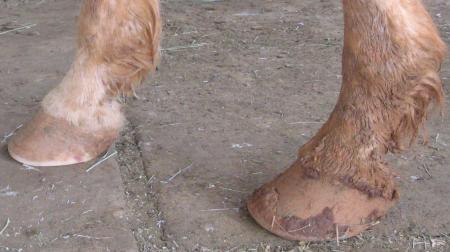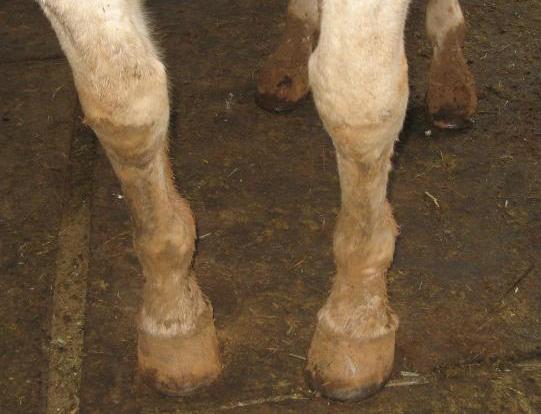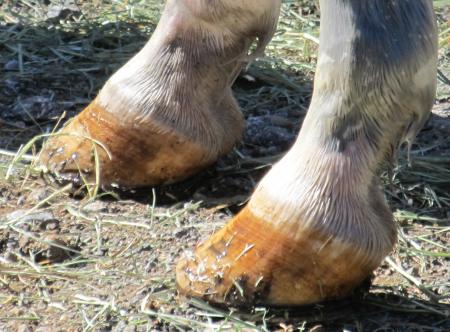This horse did well at a tough 100 mile ride despite its rather alarming shoeing.
It’s possible that Small Thing is in league with the weather gods. Last Saturday we were supposed to be galloping across the NV desert (…well, maybe doing a frantic speed-trot) on our first official distance ride. But once again, despite promising forecasts earlier in the week, by Friday the highway over the Sierra was closed from snow and ice-related accidents and the ride had been postponed for five weeks due to the swamp-like qualities of the alkali flat that was supposed to be ride camp (eloquently described as “slick as snot”).
So I had to find something else to write about.
Hoof-boot Evangelism
A discussion arose this week about how horse-folk can be very evangelical about their specific way of doing things – their way is the way – and it was suggested that hoof-booters can be a bit overbearing in their attitude at times.
Personally, I have nothing against steel shoes when applied to properly trimmed hooves – they’ve worked for a long time. On the other hand, I am biased against bad trimming – barefoot or otherwise: – flared feet, long toes – or against a cr*ppy shoeing job – I cringe when I see horses with baked-bean cans instead of feet, frogs up in the air; or more commonly, splayed feet that have little structural integrity (often accompanied by the proud statement “My horse has huge feet”) or the other favorite, ski-jump shaped toes.
‘Course, horses with cr*ppy shoeing still do well anyway. Go figure.
To opt to go barefoot is a personal preference and one that requires commitment. There’s little point trying to convince someone about its value if that person doesn’t share that philosophy.
My personal reasons for using hoof-boots are:
• With hay approaching $20 a bale, I can’t afford to pay someone to put shoes on my horse. Sad but true. If I had tons of money, would I pay someone else to trim and boot my horses for me? Probably. Groveling around in the mud can be fun, but not when you have to do it as a chore and you’re already suffering from a severe shortage of time. I can think of a multitude of other things I’d rather be doing.
• As with all things that are hard, I get personal satisfaction from doing my horses’ feet. Of course it’s easier to not have to deal with it and to sit around reading a book, eating bonbons, but not nearly as rewarding
• If I shod my horses I’d still have to stand and hold them for the farrier, so if I have to spend the time anyway I might as well do them myself, on my schedule.
• In the old days, whichever horse I shod would always be the horse that didn’t end up getting ridden (because of the horse’s health, my health, or “life stuff” going on).
• I like the control I have over their feet. With one toed-in horse and one who grows tons of toe, I like being able to poke at them at regular intervals to keep it under control. If I look at their feet and go “euw” then it’s my own fault.
• I don’t have to worry about trying to synchronize shoeing schedules with ride schedules (just as well, given that my ride schedule is making itself up as we go along).
• When I get kicked/stood on/ran over the top of, I much prefer the horse to be barefoot.
• When I’m on pavement, I don’t have to scrinch my body in angst convinced the horse will fall down (to reiterate, this is my personal paranoia and has little to do with reality).
• If you’re going to do lots of miles on a horse, doing it with the least concussion possible seems like a good plan. Boots provide protection against concussion.
• And finally, the thing that really tipped me over the edge was Roo doing an enormous spook about 50 miles into a 100 mile ride and only half wrenching his shoe off in the process – it was still firmly attached but offset by about 3/4″. Luckily it was as we were coming into the vet check and even more luckily, my farrier happened to be doing the ride and was just ahead of us so I was able to interrupt his lunch hold to ask him to reset the shoe (I’m sure he was thrilled). Never again, however, do I want to be in the position where I would potentially have to pull from a ride because of something that stupid. Not to mention the fact that usually when they wrench shoes, the horse yanks out half the hoof-wall at the same time, so there’s nothing left to nail to. And even if they don’t pull off half the hoof with the shoe, they tweak their leg and go lame.
Now admittedly, the above reasons may not be sufficient for many to make the switch – that’s their choice. One size does not fit all, and if shoes are working for them, then good. If people don’t have the desire to mess with boots – without that initial commitment, then, no, boots probably aren’t for them.
One time I can see it being appropriate to suggest a change is when people say:
“Look, my horse has [insert foot problem], how would you fix it?”.
(thinks: keep the horse barefoot and use boots – being able to work on the horse’s foot at every 1-2 weeks would eventually solve the problem, and if it’s congenital, at least you can keep it under control with regular trims)

With this kind of toe-growth, being able to trim at short intervals keeps things under control

…Or if your horse happens to have been constructed with the front legs stuck on the wrong sides. When this horse was in shoes, he needed shoeing every four weeks to keep his toed-in front feet from becoming a problem.
“My horse has sensitive feet and gets bruised easily, but I don’t want to pad” (thinks: use EasyCare Boots – voila, instant pad that you can take off afterwards).
Setting the Record Straight
This week I was contacted by Rachel Shackelford who was mentioned in a post I wrote a few months ago concerning Tevis (article here). She wanted to set the record straight regarding her horse Cody’s pull at Tevis in 2010.
It is true I wasn’t even on the US continent when this event occurred (I was in England attending my brother’s wedding, surreptitiously following the ride over the internet while trying to pretend to be a wedding guest). I was enthused to see locals Rachel and Cody doing so well that year (they were running in third place) and bummed when they showed up on the pull list. Afterwards when I asked people who’d been at the ride what happened I was told that Cody had slipped going through Foresthill (the paved portion of the ride) and returned to the vet check and pulled. Seeing in the AERC records that Cody was pulled for “surface factors” (which invariably means abrasions of some sort) I put two and two together and came up with what seemed to me the obvious scenario.
Except that’s not what happened at all.
Rachel says she was about four miles out of Foresthill on the dirt singletrack when Cody tripped on a rock and fell on his knees. Although he had no scrapes and was sound, she opted to return to the Foresthill check and have him looked over by the vets. Despite getting a clean bill of health, she still wasn’t comfortable with continuing – as she put it: “Cody …NEVER trips. He is the most sure footed horse that I have been extremely blessed to ride…he gave me a sign that it wasn’t his day” – so she opted to pull.
Given the above information, then, no – as suggested in my post – Rachel probably wouldn’t feel the need to switch from steel shoes to boots.
And in Cody’s case he retired sound after over 4,000 miles of competition so shoes evidently worked fine for him. I applaud Rachel for being able to race a horse with that many miles at that level – no flash-in-the-pan there – something I have great admiration for.
In my defense, I was writing about the train of thought I had that day – that if a horse had slipped on pavement then wouldn’t the rider want to switch to footwear with better traction? Since that isn’t what happened, it doesn’t apply to her.
My apologies for any offense caused.
—
Lucy Chaplin Trumbull
Sierra Foothills, California





